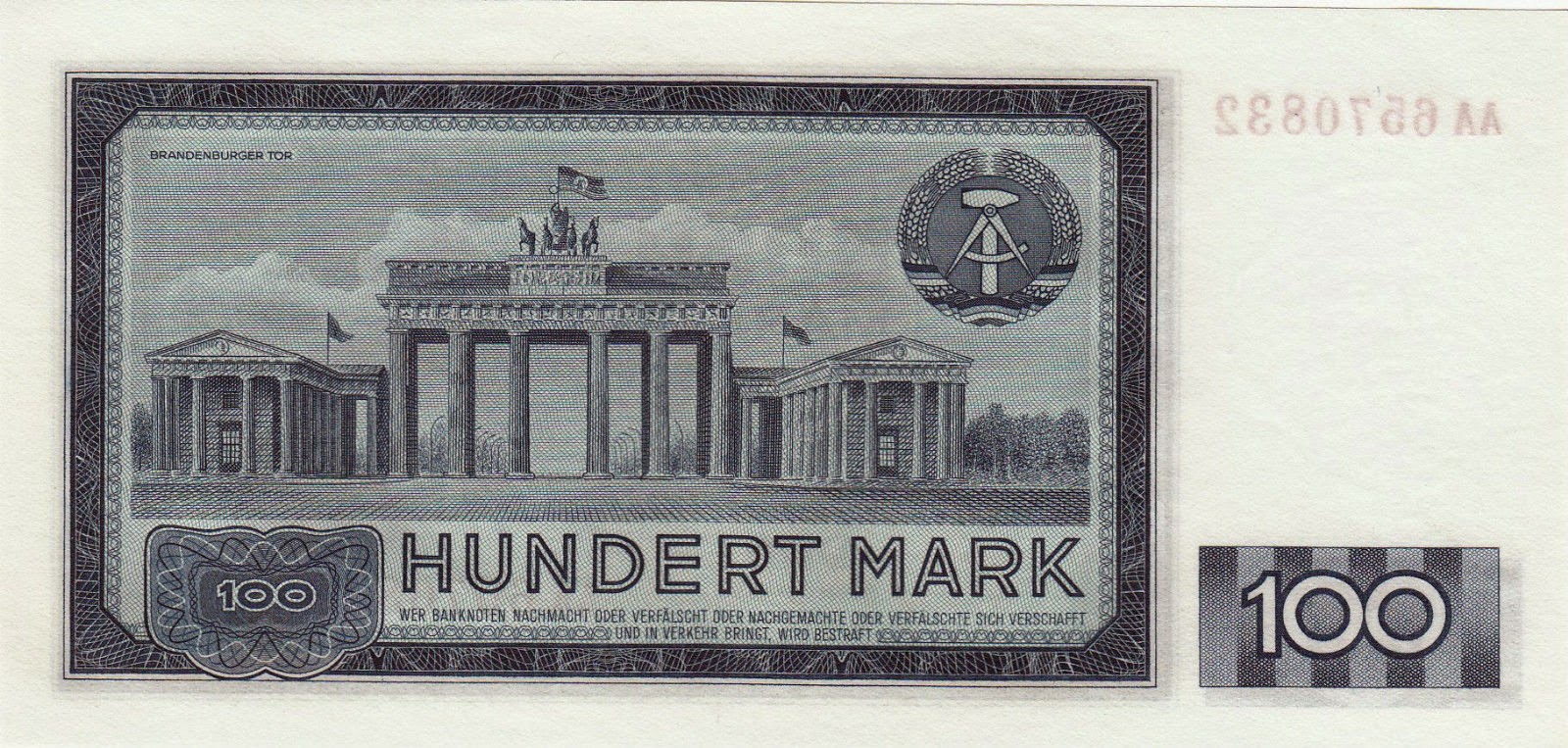German Democratic Republic Banknotes 100 Mark banknote 1964 Karl Marx
German Central Bank - Deutschen Notenbank DDR
Obverse: Portrait of Karl Marx (1818-1883), German philosopher, economist, sociologist and revolutionary socialist & National Emblem of the GDR in underprint at center.
Reverse: view of the Brandenburg Gate in East Berlin & the National Emblem of the German Democratic Republic at upper right.
Watermark: portrait of Karl Marx.
Size : 155 x 75 mm.
Printer: VEB Wertpapierdruckerei der DDR, Leipzig.
German Democratic Republic Banknotes
1964 Issue
The East German mark (Mark der DDR) in West Germany and after the reunification), in East Germany only Mark, was the currency of the German Democratic Republic (East Germany). Its ISO 4217 currency code was DDM. The currency was known officially as the Deutsche Mark from 1948 to 1964, Mark der Deutschen Notenbank from 1964 to 1967, and from 1968 to 1990 as the Mark der DDR (Mark of the GDR); it was referred to colloquially as simply the Mark. It was divided into 100 Pfennig.Karl Marx
Karl Marx (5 May 1818 – 14 March 1883) was a German philosopher, economist, sociologist, journalist, and revolutionary socialist. Marx's work in economics laid the basis for much of the current understanding of labour and its relation to capital, and subsequent economic thought. He published numerous books during his lifetime, the most notable being The Communist Manifesto (1848) and Das Kapital (1867–1894).
Born into a wealthy middle-class family in Trier in the Prussian Rhineland, Marx studied at the Universities of Bonn and Berlin where he became interested in the philosophical ideas of the Young Hegelians. After his studies he wrote for Rheinische Zeitung, a radical newspaper in Cologne, and began to work out the theory of the materialist conception of history. He moved to Paris in 1843, where he began writing for other radical newspapers and met Friedrich Engels, who would become his lifelong friend and collaborator. In 1849 he was exiled and moved to London together with his wife and children, where he continued writing and formulating his theories about social and economic activity. He also campaigned for socialism and became a significant figure in the International Workingmen's Association.
Marx's theories about society, economics and politics - the collective understanding of which is known as Marxism - hold that human societies progress through class struggle: a conflict between an ownership class that controls production and a dispossessed labouring class that provides the labour for production. States, Marx believed, were run on behalf of the ruling class and in their interest while representing it as the common interest of all; and he predicted that, like previous socioeconomic systems, capitalism produced internal tensions which would lead to its self-destruction and replacement by a new system: socialism. He argued that class antagonisms under capitalism between the bourgeoisie and proletariat would eventuate in the working class' conquest of political power and eventually establish a classless society, communism, a society governed by a free association of producers. Marx actively fought for its implementation, arguing that the working class should carry out organised revolutionary action to topple capitalism and bring about socio-economic change.
Marx has been described as one of the most influential figures in human history. Many intellectuals, labour unions and political parties worldwide have been influenced by Marx's ideas, with many variations on his groundwork. Marx is typically cited, with Émile Durkheim and Max Weber, as one of the three principal architects of modern social science.
Brandenburg Gate - Brandenburger Tor
The Brandenburg Gate (German: Brandenburger Tor) is an 18th-century neoclassical triumphal arch in Berlin, and one of the best-known landmarks of Germany. It is built on the site of a former city gate that marked the start of the road from Berlin to the town of Brandenburg an der Havel.
It is located in the western part of the city centre of Berlin, at the junction of Unter den Linden and Ebertstraße, immediately west of the Pariser Platz. One block to the north stands the Reichstag building. The gate is the monumental entry to Unter den Linden, the renowned boulevard of linden trees, which formerly led directly to the city palace of the Prussian monarchs.
It was commissioned by King Frederick William II of Prussia as a sign of peace and built by Carl Gotthard Langhans from 1788 to 1791. Having suffered considerable damage in World War II, the Brandenburg Gate was fully restored from 2000 to 2002 by the Stiftung Denkmalschutz Berlin (Berlin Monument Conservation Foundation).
During the post-war Partition of Germany, the gate was isolated and inaccessible immediately next to the Berlin Wall, and the area around the gate was featured most prominently in the media coverage of the opening of the wall in 1989.
Throughout its existence, the Brandenburg Gate was often a site for major historical events and is today considered a symbol of the tumultuous history of Europe and Germany, but also of European unity and peace.

